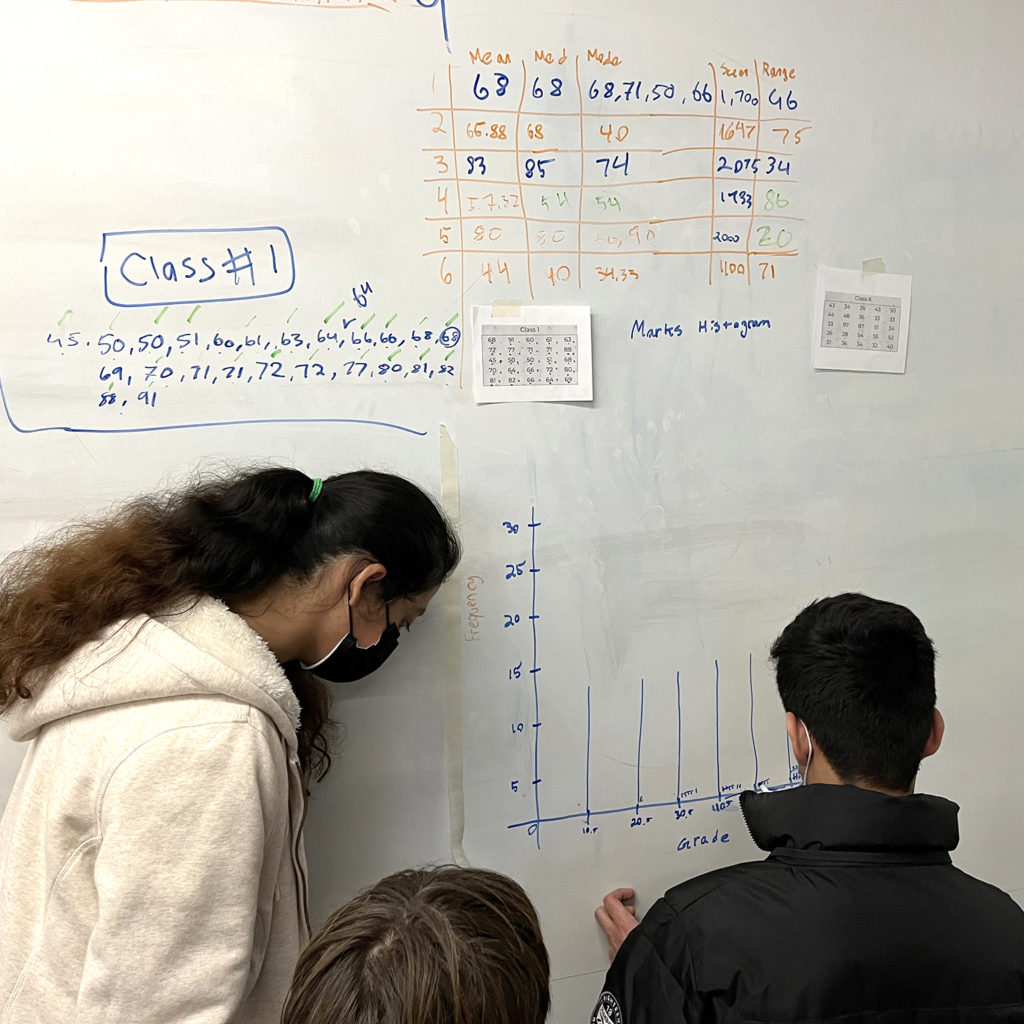Mike Skeoch is the Program Lead for Mathematics at Dr. Frank J. Hayden Secondary School. He and his team decided to take advantage of the transition period to the new Grade 9 destreamed math course in order to implement a gradeless structure. Here is what he had to share after reflecting on the first semester of running the ungraded grade 9 math course.

My journey towards ungrading really stemmed from the ongoing conversations I was having with both students and parents. The recurring thread of those conversations ALWAYS revolved around marks. Students and parents were both concerned about marks, whether it was overall course marks, marks on tests, the pressure they placed on themselves or their child around achieving a certain mark, as well as living up to certain mark standards. It really was all encompassing and I was finding that it overshadowed actually talking about the math itself and the students’ learning and progress. The priority was playing the game of school and gamifying how they could improve their mark, rather than actually caring about the learning that was happening. With the grade 9 destreamed math course launching this past September, it felt like a good opportunity to reinvent, as we were changing the structure of the course anyway. As a grade 9 team, we take advantage of this transition to the new course to also implement a gradeless structure in the course. In grade 9, no post-secondary option is looking at marks from grade 9 anyway, so there was no external pressure on having grades at that grade level.
Designing the ungraded course
Our course team worked together (Lynh Nguyen, Vikas Gupta, Steven McFadden and myself) and redesigned the math course based on strands. Students coming from grade 8 have been evaluated based on strands, so it made sense to make that shift in the grade 9 course as well. Using those math strands, we charted their progress within each strand, giving them multiple opportunities to demonstrate their learning, as well as chances to revise and improve their skills. We don’t have unit tests or quizzes in the course at all, rather we have check ins and exit passes, with the option to try easier, medium or harder questions. These were designed with a focus on giving students chances to improve on their strands. We provide feedback on those exit passes, perhaps making suggestions to try the more challenging exit pass question next time. If they have already shown their understanding in a particular area, they don’t need to be retested to do so. We really aimed to change the focus of what their learning looked and felt like; the focus was on exploring, having fun and NOT earning points.

Tracking Student Progress
In terms of tracking students’ progress through the ungraded math course, I’d definitely say this component is a “work in progress” for us as educators. We are actively tinkering with this aspect, but this is where we are headed: the class uses a lot of thinking classroom, a lot of conversations both between teacher and student, as well as between students. We have our list of different strands (from the ministry curriculum documents), and we are writing down our observations, conversations, and collecting evidence for where students are, and in general there was a lot of data we could use to be able to determine where students were along the continuum within the strands. We are looking for whether the students are consistently at course expectation standard, beyond expectations, or not there yet, which is very similar to the structure of a single point rubric. Eventually, students and parents can see a spreadsheet with their progress on those strands with all documentation linked within. As we continue to iterate on this way of designing the course, I think we are going to look to find ways to not rely only on exit passes, because students can show their understanding through multiple avenues, like conversation, or through problem solving with peers. We need to find an efficient method of capturing these conversations that we hear from students, which can then be used to supplement or even replace exit passes.
Reflections on our first iteration
Reflecting on our first attempt at doing the course in this ungraded way, there are definitely things that went well and others things that we are looking to improve on. In terms of our “wins”, our redesign using Thinking Classroom as the main method of teaching has worked really well. We receive constant feedback from students letting us know how much they enjoy working in groups, even when it isn’t with their close friends. They find the times when they are just sitting in their desks ‘boring’, and will ask to work with partners on the boards, even when we’re just checking our understanding through practice. We also noticed that the pressure on the students was at an all time low as a result of this new course structure. There was little to no anxiety in students, and so students buying in was easier for activities, as they still felt they could join in the group and participate. I have to say, it was the smoothest first week of a course ever! In terms of looking to improve as we iterate for a second time, we need to find ways to get better at documenting. In a Thinking Classroom, we are actively very engaged within the class, asking lots of questions, coaching students deeper in their thinking, all of which doesn’t leave a lot of time to step out of that moment to document student progress and document conversations. We are still trying to determine a way to document that minimizes the distractions from teaching, possibly with a tablet with a quick system to input. Another thing we’d like to improve on as we go is finding better ways to present data back to students to show them (and their parents) where they are at in their progress through the course. I feel like that will go hand in hand with improving our methods of documenting. We also plan to work on improving our end of the semester process, so we continue to improve on a number of fronts.
A learning experience
I enjoyed how Math was more relaxed this year. We didn’t have many tests which relieved most of the stress. I also enjoyed the start of the year where we got to experiment with our group members.
~Grade 9 Student
It has been a learning experience, that is for sure! We learned that it is hard to do two big things at once – creating both a new (de-streamed) course AND a new way of grading was A LOT in one semester. We learned that it will take ongoing training for teachers as they also take on this grade 9 course, to understand why we are doing this, both the reasoning behind it and all the nuances that it involves. The grade 9 math course is taught by a lot of people, and so that onboarding will be important to keep the momentum going. Importantly though, we learned through trying this gradeless approach, that it WORKS, it was safe and successful. Buy-in from both parents and students was great; parent support for this model is especially notable given the perceived “high stakes” nature of math class. Because they were entering grade 9 and high school structures were new to them overall, students didn’t have a point of reference for how high school math class should go, so that change into high school made it a natural transition point for this type of structure for the course. Students commented that while they were nervous at first about the visibly random groupings, they really appreciated that structure in the end. It allowed them to meet, and feel comfortable working with, a bunch of new students, which was especially helpful starting in grade 9. No students ever said “I wish we had tests”, that’s for sure! One comment that I especially like is that they felt they were “tricked into learning math by doing fun things”. Chalk that one up as a win! Finally, we had 100% buy-in from administration too, which is so important, having that permission and protection to try something new. They approved the purchase of additional whiteboards to facilitate the Thinking Classroom structure, and they had our backs, just in case there were any parent questions.
“Research shows three reliable effects when students are graded: They tend to think less deeply, avoid taking risks, and lose interest in learning itself.”
~Alfie Kohn “The Trouble with Rubrics”
We are really happy with this transition to a gradeless structure in Grade 9 Destreamed Math, it paired nicely with the Thinking Classroom as a classroom model. It was definitely a heavy lift at the same time as rolling out the new destreamed course, and also sort of the perfect time to do so due to the transition period to the new course. Students are thinking more deeply, are free to take risks, and we have high engagement in our Thinking Classroom activities. We look forward to continuing to play and dive deeper into this model of learning!
